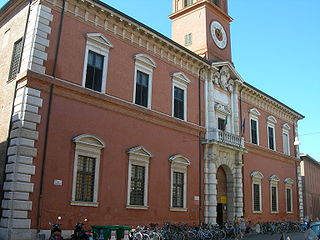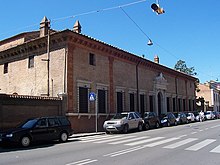
Ferrara is a city and comune in Emilia-Romagna, Northern Italy, capital of the Province of Ferrara. As of 2016, it had 132,009 inhabitants. It is situated 44 kilometres northeast of Bologna, on the Po di Volano, a branch channel of the main stream of the Po River, located 5 km north. The town has broad streets and numerous palaces dating from the Renaissance, when it hosted the court of the House of Este. For its beauty and cultural importance, it has been designated by UNESCO as a World Heritage Site.

The Duchy of Modena and Reggio was an Italian state created in 1452 located in Northwestern Italy, in the present day region of Emilia-Romagna. It was ruled since its establishment by the noble House of Este, and since 1814 by the Austria-Este branch of the family. The Este dynasty was a great sponsor of the arts, making the Duchy a cultural reference during the Renaissance and Baroque periods.

Palazzo Schifanoia is a Renaissance palace in Ferrara, Emilia-Romagna (Italy) built for the Este family. The name "Schifanoia" is thought to originate from "schivar la noia" meaning literally to "escape from boredom" which describes accurately the original intention of the palazzo and the other villas in close proximity where the Este court relaxed. The highlights of its decorations are the allegorical frescoes with details in tempera by or after Francesco del Cossa and Cosmè Tura, executed ca 1469–70, a unique survival of their time.

The Castello Estense or castello di San Michele is a moated medieval castle in the center of Ferrara, northern Italy. It consists of a large block with four corner towers.

Palazzo dei Diamanti is a Renaissance palace located on Corso Ercole I d'Este 21 in Ferrara, region of Emilia Romagna, Italy. The main floor of the Palace houses the Pinacoteca Nazionale di Ferrara.

Ercole III d'Este was Duke of Modena and Reggio from 1780 to 1796, and later of Breisgau. He was a member of the House of Este.

Francesco III d'Este was Duke of Modena and Reggio from 1737 until his death.

Maria Teresa Cybo-Malaspina was the sovereign Duchess of Massa and Princess of Carrara from 1731 until her death in 1790. From 1780 she also formally held the title of Duchess consort of Modena and Reggio. This was thanks to her unhappy marriage to Ercole III d'Este, from whom she was separated at the time.

The Galleria Estense is an art gallery in the heart of Modena, centred around the collection of the d’Este family: rulers of Modena, Reggio and Ferrara from 1289 to 1796. Located on the top floor of the Palazzo dei Musei, on the St. Augustine square, the museum showcases a vast array of works ranging from fresco and oil painting to marble, polychrome and terracotta sculpture; musical instruments; numismatics; curios and decorative antiques.
Alfonso d'Este was an Italian nobleman.

The Palazzo Bonacossi is a Renaissance architecture palace located on Via Cisterna del Follo #5 in Ferrara, Italy. The 15th-century palace is the home of the Musei Civici di Arte Antica e Museo Riminaldi.

The Palazzo Paradiso is a Renaissance palace located on Via Scienze #17 in the medieval center of Ferrara, region of Emilia-Romagna, Italy. Adjacent to the historic Jewish ghetto of Ferrara, it houses:
Alfonsino d'Este was a Ferrarese nobleman, heir apparent to Montecchio Emilia.

Marfisa d'Este was a Ferrarese noblewoman. She was the illegitimate daughter of Francesco d'Este and Maria Folch de Cardona. She and her sister Bradamante were legitimised by both pope Gregory XIII and Alfonso II d'Este. She was also notable as a patron of the arts and the protector of Torquato Tasso.
Francesco d'Este was an Italian nobleman. He was the eighth child and sixth son of Alfonso I d'Este and his second wife Lucrezia Borgia.
Bradamante d'Este was an Italian noblewoman.
The following is a timeline of the history of the city of Ferrara in the Emilia-Romagna region of Italy.
The Gallerie Estensi is a network of three museums and a library, bringing together the collective fruits of artistic production from Ferrara, Modena and Sassuolo in the Emilia-Romagna region of Northern Italy. The galleries aim to preserve the historic heritage left by the influential House of Este, with a focus on relating their noble past to the local communities at each site.

The Pinacotecta Nazionale is an art gallery in Ferrara, Emilia-Romagna, Italy. It is located on the piano nobile of the Palazzo dei Diamanti, a work of Renaissance architecture by Biagio Rossetti, commissioned by Leonello d’Este in 1447. Not to be confused with the Civic Museum on the lower floor, which has hosted temporary exhibitions of contemporary art since 1992, the Pinacoteca houses a collection of paintings by the Ferrarese School dating from the thirteenth to the eighteenth centuries. It was founded in 1836 by the Municipality of Ferrara after Napoleon's widespread dissolution of churches threatened the protection of important public artworks. The gallery is formed as much around notable northern Italian painters as it is around the exquisite interior decoration of the palace itself, together with remnants of frescoes from local churches and later acquisitions from the Sacrati Strozzi collection.













